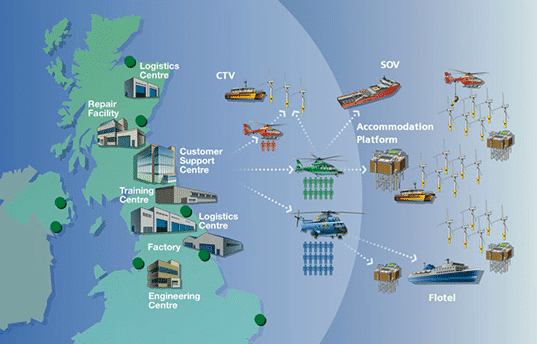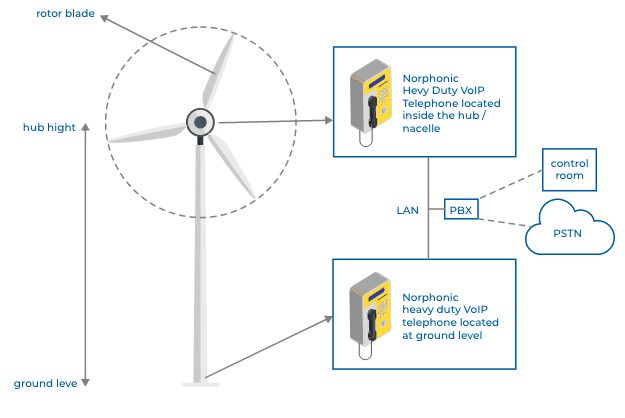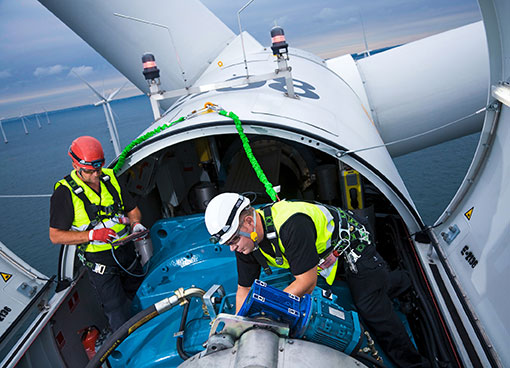
Wind Power Industry
This article is examining how Industrial Telephones can help improve communication in Offshore Wind Turbines. It will also look at critical issues that needs to be addressed when selecting an effective industrial telephone system in this environment.
Sustainable electricity for the future
Since earliest times, man has harnessed the power of the wind, with the first mill recorded as long ago as the 6th century AD. The Wind Turbine technology has developed and matured over the years and is now the fastest growing energy sector worldwide. Renewable energy is also vital in the fight against climate change and technologies such as wind energy can help in building a sustainable electricity generation system for the future.
Key Facts about Wind Power
Since earliest times, man has harnessed the power of the wind, with the first mill recorded as long ago as the 6th century AD. The Wind Turbine technology has developed and matured over the years and is now the fastest growing energy sector worldwide. Renewable energy is also vital in the fight against climate change and technologies such as wind energy can help in building a sustainable electricity generation system for the future.
- Renewable wind power must account for 20% of Europe’s energy usage by 2020, according to EU Targets. China is committing to 15%. The US have no federal targets, although most states have goals for renewable energy generation
- The wind industry internationally is able to provide at least 12% of the world’s future electricity needs by 2020 – even if current consumption doubles.
- Wind has been the fastest growing energy technology in the world for the past decade, and the pace of growth has been greatest in Europe, where around 80% of the world’s wind equipment is installed.
- Much of that growth is due to cost reductions and progressive government policies.
- If global emisssions are to be halved by 2050, investment in renewables and clean technologies must rise fourfold.

Offshore Wind Farms
Offshore wind farms are an exciting new area for the industry, largely due to the fact that there are higher wind speeds available, and economies of scale allow for the installation of larger size wind turbines offshore.
In modern wind turbines, all information related to the turbine performance is recorded by computers and transmitted to a control centre, which can be many miles away. Wind turbines are not physically staffed, although each will have periodic mechanical checks, often carried out by local firms. The onboard computers also monitor the performance of each turbine component, and will automatically shut the turbine down if any problems are detected, alerting an engineer that a site visit is required.
Heavy Duty VoIP Telephones in the Wind Power Industry
In summary, there are three key reasons why Heavy Duty VoIP Telephones are installed in wind farms:
Service Engineers or Maintenance Staff need to have the opportunity to communicate with the outside world to ensure the business critical operation of the wind power system, including service, maintenance and repair issues.
Mobile telephones have limited coverage in remote areas, and even when they have coverage, high ambient noise (from wind or machinery) means that these telephones do not have a loud enough sound to be clearly heard.
Conventional telephones are not robust enough to perform in these industrial areas, as communications technology utilised need to be weather proof and able to deal with ongoing exposure to vibration, dust, extreme temperatures and seawater.
Norphonic has a long history of delivering Heavy Duty VoIP solutions inside Wind Turbines in many countries, ensuring essential voice communications when it is most needed. In the remaining part this review we shall look at some of the issues that needs to be addressed when selecting your telephone solution.
Primary Considerations – VoIP Telephones in Wind Farms
Keeping in mind the average size of an Offshore Wind Turbine (120m high with 40m long blades) there are usually two Heavy Duty VoIP telephones installed in a turbine, so that engineers are able to communicate with each other during a site visit. The below figure illustrates a typical example installation. In this case the telephones are connected via LAN (Local Area Network) to each other, and then to a central control room or to the PSTN (Public Switched Telephone Network) via a PBX (Private Branch Exchange) or VoIP Gateway solution to enable communication with the outside world.

VoIP vs. Analogue Telephones?
In Wind Turbines, the telephone of choice will almost exclusively always be a VoIP telephone. There are many reasons for this, but mainly, since the VoIP telephone use data networks it has additional functionalities that are partiularly important when it comes to Wind Turbines.
One feature, found in all Norphonic VoIP telephones, is the opportunity for the telephone to carry out self monitoring and automatic fault checks of all telephone components, which is useful because the turbine owner would not want to dispatch a service engineer if not strictly neccessary due to the high cost involved with these maintenance visits.
Another key feature, is the remote management functionality, whereby a remote operator has the opportunity to load telephone software updates remotely, switch the telephone on/off, sense if the hook is in an on/off position and monitor condition of telephone components. Finally, a VoIP telephone can be used to send data as well as voice, which means that service engineers can send pictures of faulty equipment as the case may be, or other data if deemed neccessary.
In modern wind turbines, all information related to the turbine performance is recorded by computers and transmitted to a control centre, which can be many miles away. Wind turbines are not physically staffed, although each will have periodic mechanical checks, often carried out by local firms. The onboard computers also monitor the performance of each turbine component, and will automatically shut the turbine down if any problems are detected, alerting an engineer that a site visit is required.
What to look for in a Heavy Duty VoIP Telephone solution?
There are many issues that needs to be addressed prior to commissioning a Heavy Duty VoIP system for a Wind Turbine, such as evaluating the installation environment, functionality and temperature ranges. Below are some key pointers to look at when choosing a Heavy Duty VoIP Telephone for your Wind Turbine Application:
- Is the telephone based on open SIP standards which will allow connectivity to your existing networks and systems? If the product is based on open standards, this will also mean that the product installation can be upgraded or changed in the future without having to change the entire system.
- Is the telephone weather proof? Wind Turbines can be notoriously dirty environments with large amounts of dust and grime collecting over time. It is therefore recommended that the telephones are dustproof / have the highest protection available against Dust ”6”, and that the unit is waterproof to a degree of ”5” –An IP rating to IP65 is recommended for both offshore and onshore wind turbines. See definition of Ingress Protection in the below Glossary for further information.
- Does the telephone incorporate a self monitoring and fault check function? This is a feature available on all Norphonic telephones, which means that the status of the telephones can be monitored from a remote location, saving you considerable maintenance costs.
- What is the telephone operation temperatures? wind turbines should be able to operate in temperatures between -20° C and +55° C
- Does the telephone incorporate VSQ – Voice Sound Quality? This is a standard feature in all Norphonic telephone systems, ensuring loud and clear sound, even in noisy ambiance areas.
- Is the telephone condensation proof? –This can otherwise lead to severe problems in operation as water can easily form inside the unit, affecting performance.
- Does the VoIP telephone incorporate a QoS – Quality of Service functionality? This feature, found in all Norphonic telephones, guarantees a certain level of performance in a data flow, ensuring impeccable delivery of voice communications in an IP Network.
- For offshore wind turbines, is the telephone seawater resistant?
- Has the telephone been installed in other Wind Turbines in the past? –It is always reccommended that you check if the telephone has been used for this particular purpose in the past to evaluate suitability.
- Is the telephone CE approved? CE marking means that the product is certified to meet EU consumer safety, health or environmental requirements. End users should be aware that some telephones use the intentionally confusing term ”CE” for ”China Export”, and the only way consumers can check this is to closely examine the CE mark/ logo as the two logos are very similar.
- Is the telephone highly visible and identifiable so that they can easily be located by your onsite service engineers?
Copyright Notice
All content on this page is owned by Norphonic and you agree not to copy, communicate to the public, adapt, distribute, transfer, sell, modify or publish any contents of this web page without express pror written consent from the owner. Norphonic and all other trademarks used in this web-page are trademarks of their respective owners.
Relevant information links:
- Wind Power Telephone Application Guide
- Siemens Wind Power selects Norphonic (Case Study)
- Norphonic Telephones for Emergency and Industrial Areas

